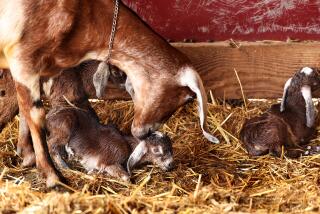Goats Are West’s Latest Weed Whackers
- Share via
GOLDEN, Colo. — It was just after dawn when Jim Guggenhime and his crew trotted past the tennis courts and onto the lawns of the Mount Vernon Country Club.
They made short work of the leafy spur, knapweed and poison ivy, pausing occasionally to cough up a thistle that went down the wrong way.
One bloated employee lifted his head.
“Get back to work!” shouted Guggenhime.
“Maaaaa!” he retorted weakly.
Guggenhime rolled his eyes.
“Even though they work for me, I still find them adorable,” he said.
As someone who just spent 10 days sleeping in a truck with more than 200 goats, Guggenhime hardly seems a man ahead of his time.
And yet as Colorado and the rest of the West grapple with how best to kill noxious weeds, more people are favoring the spindly goat over polluting mowers and poison sprays.
Guggenhime owns Nip it in the Bud, a company that rents out goats to eat weeds. He’s only been in business a month but he’s already lined up enough contracts to last well into fall.
“We are entirely booked,” he said, looking happily disheveled among the knee-high weeds and bobbing, bleating goat heads. “It’s the ultimate organic solution.”
The country club in Golden is just the latest place to find goats in Colorado.
The shaggy beasts seem to be cropping up like weeds themselves.
They have been used to clear brush in downtown Denver. In Colorado Springs, they are eating vegetation that sparks wildfires. Along highways and median strips goats can be seen blithely browsing on thorny, gnarly branches. And there are plans to enlist them to help defeat the tamarisk, one of the most tenacious plant pests in the West.
“It’s a lawnmower with legs,” said Eric Lane, Colorado state weed coordinator. “It’s growing in popularity because it strikes people as natural weed control. They also look better than a guy in a moon suit spraying strange chemicals all over the place.”
Boulder, a city that prides itself on being environmentally conscious, is giving goats a test run.
“The goats will eat the weed down to the root system,” said Patrick Tarver, a maintenance supervisor for the city. “We started this week, and if it works out we will use them all the time. It totally fits into the Boulder mentality.”
Goats, long the black sheep of the farm-animal family, may not be as cute as lambs or as elegant as horses but they eat just about anything. Cactus, thistles and hemlock -- plants that can be deadly to humans -- are consumed with gusto. Contrary to urban legend, they don’t eat tin cans or clothes, though they’ll happily nibble both. Powerful enzymes in a goat’s saliva neutralize toxins so that the biggest threat it faces is eating itself to death.
“If I put them in a field of alfalfa all day, many of them would be dead by the morning,” Guggenhime said. “They’d just keep eating.”
Wyoming, California, New Mexico, Arizona and Utah have used goats on a limited basis. Utah’s Department of Agriculture is pushing cities and towns to try their luck with goats. Murray, a suburb of Salt Lake City, employed 100 animals last month to clear weeds out of its local parks.
“They ate the weeds right to the ground,” said Doug Hill, the city’s public services director. “The people loved them; it was like a petting zoo out there.”
Goat aficionados say eating weeds is just one of many benefits the animals offer.
“Goats aerate the soil, mulch the soil, fertilize the soil and irrigate it,” said Lani Malmberg, a pioneer of commercial goat grazing. “With all the pesticides that have been sprayed, there shouldn’t be a single weed on the planet, but there is.”
Malmberg, 45, a former rancher, said she’s a gypsy. She spends her days driving around the West in her camper with 1,100 weed-eating cashmere goats following by truck. Business is so good that she is handing much of it off these days to newcomers like Guggenhime.
“It’s catching on fast because the public is demanding less use of chemicals in their air, water and land,” she said. “I am now training people in five states how to get started in this business.”
Malmberg, who started grazing goats in 1997 and has a master’s degree in weed science, has clients that include national parks, state parks, the city of Cheyenne, Wyo., and ranchers throughout the West.
“We are partners, this herd and I,” she said. “We have a good rapport. They are always polite and they trust that I will take good care of them. I know that must sound funny, but it’s true.”
When hired, the goats are taken to the site and left to graze. An electric fence keeps them from running off or eating what they shouldn’t. A dog helps maintain order. When one area is done, the goats are moved to another. The cost varies from about $1 to $1.50 per goat, per day.
Barbara Nugent, director of parks for El Paso County, hired 1,000 goats to work 600-acre Bear Creek Park in Colorado Springs because she didn’t want to spray near water supplies and around so many people.
“The goats are just knocking themselves out,” she said. “They are all natural -- they don’t make noise and they don’t create fossil-fuel waste. We put seed packs on their back so they can plant while grazing.”
The goats even ate 500 old Christmas trees, leaving just stumps behind.
But Nugent worried that what went in might come out.
“We picked up goat poop and planted it to see if the weeds would grow back,” she said. “We watched it and watered it but we got no weeds.”
Back at the country club, the goats serenely chomped through a thicket of thistle. Occasionally one escaped the pen, then cried plaintively to come back inside.
“They are very curious and very social,” said Guggenhime, as he wrestled an errant goat to the ground and carried it back to the pen. “They have friends and they have enemies, but they don’t like to be alone.”
The other goats stopped eating for a second to see what the fuss was about, then resumed their work.
Guggenhime, 27, grew up in California’s Marin County, but it was a trip to Kenya and Tanzania that got him excited about goats.
“Goats were everywhere,” he recalled. “I always fancied the rural lifestyle, and when I came back I decided I wanted to get goats.”
The idea was to raise a small amount for meat, milk or even for pack animals. Some goats, he said, produce milk “that tastes like melted ice cream.”
“But it was nothing that would make me a living,” he said.
Eventually, he bought some goats from Malmberg and started a business on a small farm in Colorado. Now he works almost every day with only his wife to help out.
Guggenhime rises at dawn to set up fences and start the animals grazing.
And though he finds them “adorable,” goats have some fairly objectionable habits, like males who urinate on their own faces to attract mates.
“Yeah, they can smell pretty bad sometimes,” Guggenhime says. “Goats have always gotten a bad rap. Even God came out against them.”
The Bible says on Judgment Day the nations of the Earth will be separated like sheep and goats. The sheep will be on the right side, the goats on the left. The sheep will go to heaven while the goats will get eternal damnation.
“It’s really not fair,” Guggenhime said. “Look at all the uses goats have, look at how much they have given us. And all they basically do is eat.”
More to Read
Sign up for Essential California
The most important California stories and recommendations in your inbox every morning.
You may occasionally receive promotional content from the Los Angeles Times.










